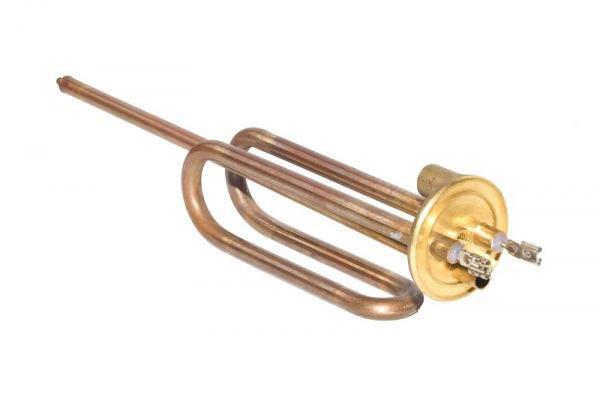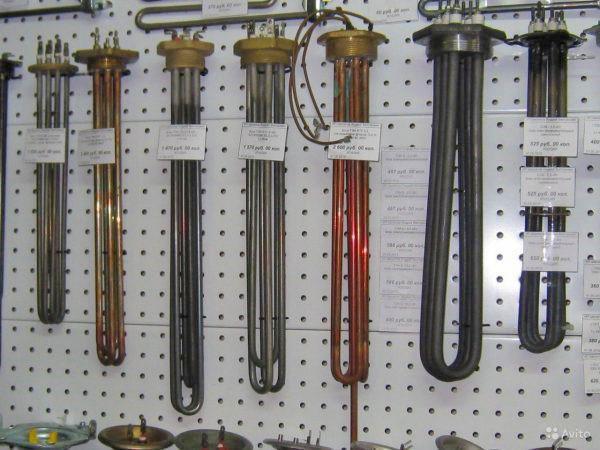Heating element for a water heater - the procedure for operation and replacement
 To heat water in any circuit, it is necessary to give energy from wood, gas or electricity. Teng for a water heater is a unit where electrical energy passes through nichrome spirals, heats them, and heat is given to water through metal or ceramics. In effect, the heating element and the internal water circuit are functional parts of the water heater. All other equipment is needed to ensure the process in the given parameters.
To heat water in any circuit, it is necessary to give energy from wood, gas or electricity. Teng for a water heater is a unit where electrical energy passes through nichrome spirals, heats them, and heat is given to water through metal or ceramics. In effect, the heating element and the internal water circuit are functional parts of the water heater. All other equipment is needed to ensure the process in the given parameters.
Varieties of water electric heating elements

To clean the heating element from scale, it must be immersed in hot water with antiscale or held in a citric acid solution. Then make sure the integrity of the case.
Another type of heating element is a design where the conductor is placed in the bulb without contact with water. And such a device is considered a "dry" heating element or closed. Each of the elements has its own advantages and disadvantages.
The device and application of thermoelements
 The resulting heating tube can be bent and the part made so that it can be installed in the vessel. In this case, the upper metal casing is made of a conductor with good heat transfer - steel, copper, alloys. The heating element for the water heater can be fixed in the vessel with a flange or both ends of the element with separate nuts. Any water except distilled water contains salts. Some of them, when heated, become insoluble and settle on metal tubes. The process also takes place because copper tubes are a precipitation catalyst.
The resulting heating tube can be bent and the part made so that it can be installed in the vessel. In this case, the upper metal casing is made of a conductor with good heat transfer - steel, copper, alloys. The heating element for the water heater can be fixed in the vessel with a flange or both ends of the element with separate nuts. Any water except distilled water contains salts. Some of them, when heated, become insoluble and settle on metal tubes. The process also takes place because copper tubes are a precipitation catalyst.
If you put a rod of a more active metal next to it, then aggressive ions will come into contact with it. Then the magnesium anode electrode is destroyed, covered with a loose crust, there are not enough ions for the formation of a deposit on the heating element. Thus, the service life of the main elements is extended, and the magnesium electrodes are replaced with new ones when worn. Therefore, all heating elements for a water heater are equipped with a magnesium anode.
 Dry heating elements are arranged differently. They are insensitive to sediment, do not enter into electrochemical interaction with water, and do not overgrow even in a harsh environment. Accordingly, it is not necessary to install the anode element with them. These are not heating elements, since the device cannot be called a tubular electric heater. Such elements are prepared for a specific model of a water heater.
Dry heating elements are arranged differently. They are insensitive to sediment, do not enter into electrochemical interaction with water, and do not overgrow even in a harsh environment. Accordingly, it is not necessary to install the anode element with them. These are not heating elements, since the device cannot be called a tubular electric heater. Such elements are prepared for a specific model of a water heater.
What heaters are installed in Termeks boilers
 The company uses heating elements for the Termeks water heater from various manufacturers. In addition to the Italian site, the production of electrodes was launched in China. There is a control laboratory at the exit. Elements with low resistance are rejected.
The company uses heating elements for the Termeks water heater from various manufacturers. In addition to the Italian site, the production of electrodes was launched in China. There is a control laboratory at the exit. Elements with low resistance are rejected.
For a greater guarantee at home, before installing the heaters, they need to be kept in water for several hours and check whether the resistance corresponds to that specified in the passport.
For water heaters Termeks produce the following types of heating elements:
- for flow taps, heaters with a capacity of 3.3, 2.5, 5.5 kW;
- on a stamped flange D 64 mm - 2.0 1.5 kW, D 82 mm - 1.5 kW, D 92 mm - 1.5, 2.0 kW;
- without flanges, with fastening on nuts - 0.7, 1.3, 2.0 kW;
- magnesium anodes of a special composition, only in Italy.
The company has developed a special composition for the production of AZ63 plus alloy anodes, which are 2 times more efficient than conventional anodes.
Heating elements for boilers of the Ariston company
 The Ariston company uses heating elements of its own production or orders from the Thermowatt factory in Italy. Heating elements in copper and steel design, for vertical vessels, straight and bent, for those lying on their side.
The Ariston company uses heating elements of its own production or orders from the Thermowatt factory in Italy. Heating elements in copper and steel design, for vertical vessels, straight and bent, for those lying on their side.
Nut and flange heating elements are used for water heaters Ariston, with proprietary flange diameters - 42, 48, 63, 72 mm and equipped with metric threads. Heating elements are mainly used and there are models with a closed structure of elements. All heaters have a power of 1-4 kW. Six series of Tens are used in 80 types of water heaters, only in the ARI STEA TITE and ABS SLV models there are dry elements with a service life of 7-10 years without replacement.
Ariston water heaters have thermostatic temperature control in the range from 20 to 80 degrees, which extends the service life of heating elements. Replacement of magnesium electrodes occurs as needed.
Five series of electrodes are made using copper tubing, and only one series using stainless steel. Heating elements of the RNCA series are designed for small boilers with a volume of 30 and 50 liters.
The professional attitude towards the Ariston water heater, the use of specially created heating elements for it, gave the results:
- silver plating of contacts made it possible to raise the current strength to 25 amperes against 18 for competitors;
- fast heating of water is provided due to high heat transfer;
- easy installation of heating elements, and long-term operation without repair.
Heating elements of the Swedish company Electrolux
 The Swedish company Electrolux uses its own heating elements and products from the Italian Thermowatt plant. High-quality products are produced in a large assortment, are reliable and do not overgrow. Heating elements come into disrepair for heaters Electrolux for reasons:
The Swedish company Electrolux uses its own heating elements and products from the Italian Thermowatt plant. High-quality products are produced in a large assortment, are reliable and do not overgrow. Heating elements come into disrepair for heaters Electrolux for reasons:
- a metal tube bursts from prolonged temperature overheating or high voltage;
- corrode attachment points;
- there is no magnesium anode;
- the heater is not completely submerged in water.
All cases of failure of heating elements are associated with violations of the rules for operating the device.
The influence of the thermostat on the service life of the heating element
 Water heaters have mandatory overheating protection. When the critical temperature is reached, the device turns off. The temperature in the water heater is controlled using a thermostat. In this case, the temperature sensor is;
Water heaters have mandatory overheating protection. When the critical temperature is reached, the device turns off. The temperature in the water heater is controlled using a thermostat. In this case, the temperature sensor is;
- a rod lowered into the vessel parallel to the heater;
- a capillary device, in which the membrane closes contact when the volume of liquid increases;
- electronic node.
Thermostats are simple and programmable, overhead and mortise. They cannot be repaired, they are replaced during installation with similar ones.
Heating elements for a water heater with a thermostat operate in a gentle mode. If an economical heating mode is used up to 55 degrees, the conditions for the deposition of hardness salts are not created and the heating element remains clean for a long time, which means it does not overheat.
In addition, the heating element with a thermostat is very convenient to use, simply by heating water in any container.
The procedure for replacing heating elements in water heaters
 To clean or replace the heating element in the water heater from scale, it is necessary to provide access to the device by emptying and draining the container. In this case, it is necessary to ensure equalization of the pressure in the vessel.
To clean or replace the heating element in the water heater from scale, it is necessary to provide access to the device by emptying and draining the container. In this case, it is necessary to ensure equalization of the pressure in the vessel.
For the duration of the work being carried out, the water heater is not only disconnected from the outlet, but the machine on the line is turned off. You can assemble the circuit and turn on the water heater after water flows from the drain tap.
To ensure inspection and repair of the device, it is necessary to turn over and dismantle the flange with the attached heating element. Disconnect power. First, you need to sketch or photograph the wiring fastening on the flange in order to assemble the circuit correctly after replacing the node. At the same time, it is necessary to replace or clean the anode rod of sediment.
Wash gaskets and gaskets from dirt, replace with new ones if necessary. Install a new heating element and reassemble in the reverse order. When filling the tank with water, open the drain cock to displace the air.